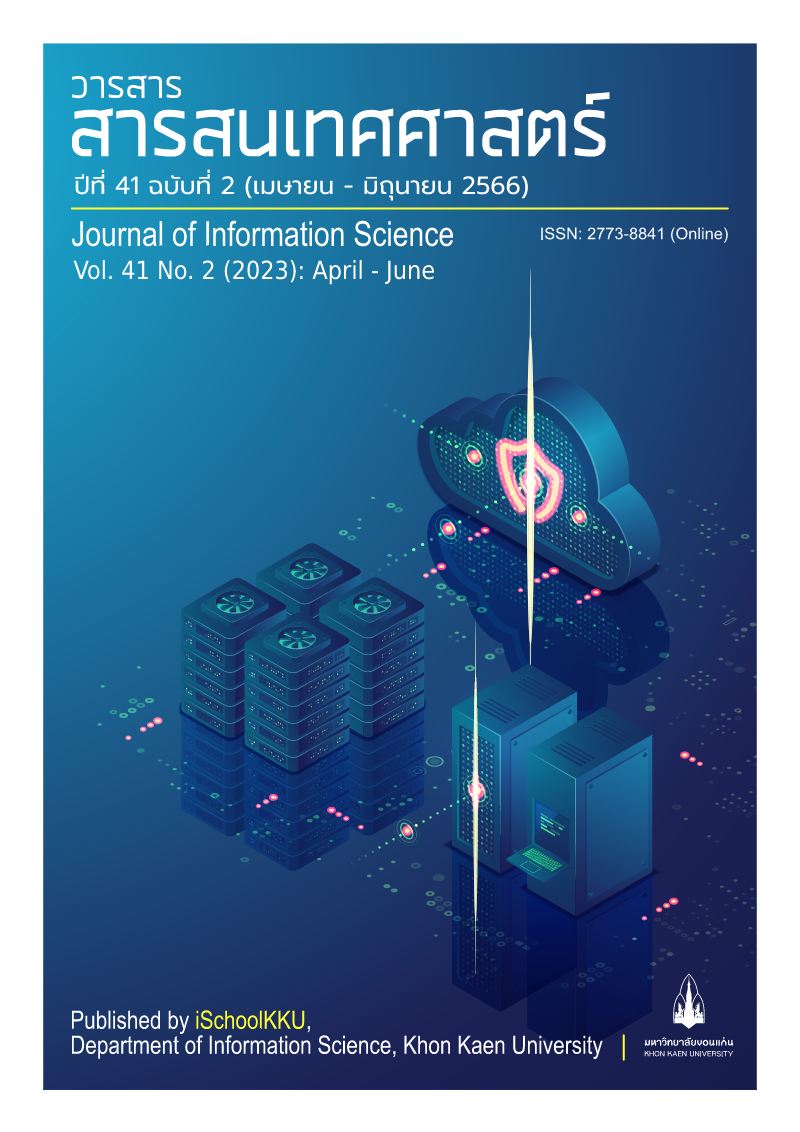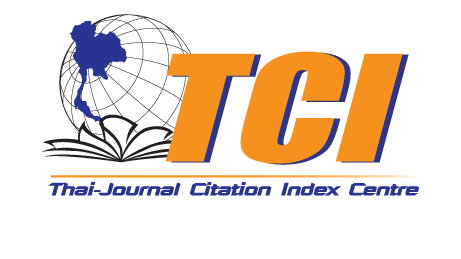การประเมินความต้องการจำเป็นและการออกแบบบริการสนับสนุนการวิจัยของผู้ใช้ห้องสมุดสถาบันอุดมศึกษา
DOI:
https://doi.org/10.14456/jiskku.2023.14คำสำคัญ:
การบริการสนับสนุนการวิจัย , การบริการห้องสมุด, ห้องสมุดสถาบันอุดมศึกษา , การออกแบบบริการ , การออกแบบบริการห้องสมุดของไอดีโอ , พิมพ์เขียวการบริการบทคัดย่อ
วัตถุประสงค์: เพื่อประเมินความต้องการจำเป็นของการบริการห้องสมุดในการทำวิจัยของผู้ใช้ห้องสมุดสถาบันอุดมศึกษา และเพื่อสร้างพิมพ์เขียวการบริการสนับสนุนการวิจัยของห้องสมุดสถาบันอุดมศึกษา โดยใช้วิธีการออกแบบบริการห้องสมุดของไอดีโอ ซึ่งประกอบด้วย 3 ขั้นตอน ได้แก่ การค้นหาและรวบรวมแรงบันดาลใจ การคิดอย่างสร้างสรรค์ และการทวนซ้ำ
วิธีการศึกษา: การวิจัยนี้ใช้วิธีวิจัยแบบผสานวิธีในการเก็บข้อมูลวิจัยด้วยแบบสอบถาม แบบสัมภาษณ์ และแบบประเมิน กลุ่มตัวอย่างที่ใช้ในการวิจัย ได้แก่ ผู้ใช้ห้องสมุดสถาบันอุดมศึกษา จำนวน 405 คน และกลุ่มผู้ให้ข้อมูลหลัก จำนวน 10 คน ซึ่งเป็นอาจารย์และนักศึกษาระดับบัณฑิตศึกษาสถาบันอุดมศึกษาในประเทศไทยที่ถูกจัดอันดับด้านการวิจัยโดย Times Higher Education คัดเลือกโดยวิธีเลือกแบบเจาะจง สถิติที่ใช้ในการวิเคราะห์ข้อมูล ได้แก่ ค่าเฉลี่ย ส่วนเบี่ยงเบนมาตรฐาน และ Priority Needs Index แบบปรับปรุง (PNImodified) สำหรับข้อมูลเชิงปริมาณ รวมทั้งใช้การวิเคราะห์เนื้อหาสำหรับข้อมูลสัมภาษณ์
ข้อค้นพบ: ผู้ใช้ห้องสมุดสถาบันอุดมศึกษามีความต้องการจำเป็น อันดับ 1 คือ ด้านการบริการตอบคำถามและช่วยการค้นคว้า (PNImodified = 0.23) และความต้องการจำเป็นรายข้อ อันดับ 1 คือ การแนะนำแหล่งทุนวิจัย (PNImodified = 0.31) ส่วนพิมพ์เขียวการบริการสนับสนุนการวิจัยของห้องสมุดสถาบันอุดมศึกษา มี 3 องค์ประกอบ ได้แก่ 1) จุดสัมผัสทางกายภาพ ประกอบด้วย สิ่งที่ปรากฏต่อสายตาของผู้ใช้และการทำกิจกรรมของผู้ใช้ 2) ปฏิสัมพันธ์ส่วนหน้า ประกอบด้วย งานบริการตอบคำถามและช่วยการค้นคว้าซึ่งเป็นบริการส่วนหน้าของห้องสมุด และ 3) ปฏิสัมพันธ์ส่วนหลัง ประกอบด้วย งานบริการส่วนหลังของห้องสมุดและงานสนับสนุนการบริการของห้องสมุด และมีกิจกรรม 4 ขั้นตอน ได้แก่ การเริ่มบริการ การส่งคำถาม การรับคำถาม และการจบบริการ ซึ่งเน้นการบริการแบบออนไลน์ที่มีปฏิสัมพันธ์ โดยใช้เทคโนโลยีปัญญาประดิษฐ์ และการวิเคราะห์ข้อมูลผู้ใช้ ที่สามารถบริการได้อย่างสะดวก รวดเร็ว และตรงความต้องการเฉพาะบุคคลมากที่สุด พิมพ์เขียวการบริการดังกล่าวผ่านการประเมินจากผู้ให้ข้อมูลหลัก โดยภาพรวมอยู่ในระดับมาก (x̅ = 4.34) เมื่อพิจารณารายด้าน พบว่า ด้านอรรถประโยชน์อยู่ในระดับมากที่สุด (x̅ = 4.46) รองลงมา คือ ด้านความถูกต้องอยู่ในระดับมาก (x̅ = 4.40) ด้านความเหมาะสมอยู่ในระดับมาก (x̅ = 4.33) และด้านความเป็นไปได้อยู่ในระดับมาก (x̅ = 4.16) ตามลำดับ
การประยุกต์ใช้จากการศึกษานี้: ผลการวิจัยนี้จะเป็นแนวทางในการออกแบบบริการที่เน้นผู้ใช้เป็นสำคัญและการบริการเชิงรุกที่ตรงความต้องการผู้ใช้และสอดคล้องกับสถานการณ์ปัจจุบัน รวมทั้งช่วยส่งเสริมนโยบายและการจัดการเรียนการสอนของสถาบันอุดมศึกษาที่เน้นการวิจัย
Downloads
เอกสารอ้างอิง
Aneksuk, S. (2013). Statistical methods for research. (In Thai). Chon Buri: Department of Educational Research and Measurement, Burapha University
Bangsalee, Y. (2016). University faculty members’ expectations towards research support roles of librarians. (In Thai). Master’s thesis, Chulalongkorn University
Best, J. W. (1981). Research in education (4th). New Delhi: Prentice-Hall.
Borrego, Á., & Anglada, L. (2018). Research support services in spanish academic libraries: An analysis of their strategic plans and of an opinion survey administered to their directors. Publications, 6(4).
Brown, S., Gustafsson, A., & Witell, L. (2009). Beyond products. Wall Street Journal/MIT Sloan, 22.
Chaisuwan, A. & Nuntapichai, S. (2019). Collection development service design: Concept & challenge for supporting online learning. (In Thai). Retrieved from http://pulinet2019.buu.ac.th/ Documen tation/Proceeding/Oral/CRM/19.pdf
Corrall, S., Kennan, M.A. and Afzal, W. (2013). Bibliometrics and Research Data Management Services: Emerging Trends in Library Support for Research. Library Trends, 61, 636-674. https://doi.org/10.1353/lib.2013.0005
Gasparini, A. A. (2019). Design thinking for design capabilities in an academic library. (Doctoral dissertation). University of Oslo, Norway.
Haddow, G., & Mamtora, J. (2017). Research support in Australian Academic Libraries: Services, resources, and relationships. New Review of Academic Librarianship, 23(2-3), 89-109.
IDEO. (2015). Design thinking for libraries: A toolkit for patron-centered design. Retrieved from http:// designthinkingforlibraries.com/
Interaction Design Foundation. (2020). Service blueprints - communicating the design of services. Retrieved from https://www.interaction-design.org/literature/article/service-blueprints-communica ting -the-design-of-services
Johnson, A., Kuglitsch, R., & Bresnahan, M. (2015). Using participatory and service design to identify emerging needs and perceptions of library services among science and engineering researchers based at a satellite campus. Issues in Science and Technology Librarianship, (81). https://doi.org/10.29173 /istl1652
Krejcie, R. V., & Morgan, D. W. (1970). Determining sample size for research activities. Educational and Psychological Measurement, 30(3), 607-610.
Kuruppu, P. U. (2007). Evaluation of reference services a review. The Journal of Academic Librarianship, 33(3), 368-381.
Leenaraj, B. (2012). Model of research support services for research university libraries in Thailand. (In Thai). Doctoral dissertation, Khon Kaen University.
Li, Qing & Zhang, Huaige & Hong, Xianpei. (2019). Knowledge structure of technology licensing based on co-keywords network: A review and future directions. International Review of Economics & Finance, 66, 154-165. https://doi.org/10.1016/j.iref.2019.11.007
Luca, E., & Ulyannikova, Y. (2020). Towards a user-centred systematic review service: The transformative power of service design thinking. Journal of the Australian Library and Information Association, 69(3), 357-374.
Marlina, E., & Purwandari, B. (2019). Strategy for research data management services in Indonesia. Procedia Computer Science, 161, 788-796.
Noibuatip, M. (2018). Information seeking behavior for research of the staff of Mahasarakham University. (In Thai). Journal of Library and Information Science Srinakharinwirot University, 11(2), 172-184.
Office of Thai Trade and Economy. (2019). Two creative Thai companies join hands with Taiwan entrepreneurs to produce creative works to the world market. Retrieved from https://globthai land.com/taiwan-23072019
Office of the Higher Education Commission. (2020). Dalodosathit udomsuksa [Download higher education statistics]. (In Thai). Retrieved from http://www.info.mua.go.th/info/
Parker, R. (2012). What the library did next: Strengthening our visibility in research support. In emPowering efutures: VALA 2012 16th Biennial Conference, Melbourne, Australia, 6-9 February 2012. Retrieved from http://www.vala.org.au/vala2002-proceedings
Phophueksanand, N. (2013). Research methodology. (In Thai). Bangkok: Expernet.
Prasithrathsint, S. (2003). Social science research methodology. (In Thai). Bangkok: Farharm.
Raju, R., & Schoombee, L. (2014). Research support through the lens of transformation in academic libraries with reference to the case of Stellenbosch University Libraries. South African Journal of Libraries and Information Science, 79(2), 27-38.
Rasul, A., & Singh, D. (2011). The role of academic libraries in facilitating postgraduate students' research. Malaysian Journal of Library & Information Science, 15, 75-84.
Schauer, B. (2009). Service blueprint for service design panel. Retrieved from https://www.flickr.com /photos/brandonschauer/3363169836/
Scimago Lab. (2020). Scimago Journal & Country Rank. Retrieved from https://www.scimagojr.com/ countryrank.php
Serirak, N. & Deerajviset, P. (2018). Wichai mai chai rưang yak [Research is not difficult]. (In Thai). Bangkok: Chula Book Center.
Sobol, B. (2020). Conveying complexity in contemporary academic library service models. Partnership, 15(1), 1-21.
Srisaard, B. (2011). Kanwichai bưangton [Basic research]. (In Thai). Bangkok: Suweeriyasan.
Suptanon, J. (2009). Developing a model for promoting research of university professors. (In Thai). Doctoral dissertation, King Mongkut's University of Technology North Bangkok
Tanjankoon, W. (2018). The concurrent, problems, and needs for the research support services of the library users in provincial university library network. (In Thai). Retrieved from http://pulinet2019.buu.ac.th/Documentation/Proceeding/Poster/CRM/25.pdf
Tepwong, P. (2017). Development of a model for research supportinformation service for research university: case study of faculty of environment and resource studies library, Mahidol University. (In Thai). Master’s thesis, Burapha University.
Termpittayapaisith, A. (2010). Thailand’s creative economy. (In Thai). Bangkok: Office of the National Economic and Social Development Council.
Thailand Creative & Design Center. (2014). Service design workbook. (In Thai). Bangkok: Author.
Times Higher Education. (2020). World University Rankings 2020. Retrieved from https://www.timeshighereducation.com/world-university-rankings/2020/world-ranking
Trischler, J., Pervan, S., Kelly, S., & Scott, D. (2018). The value of codesign: the effect of customer involvement in service design teams. Journal of Service Research, 21, 75-100.
Wójcik, M. (2019). How to design innovative information services at the library? Library Hi Tech, 37(2), 138-154.
Wongwanich, S. (2015). Kan wicai pramoen khwamtongkan campen [Needs assessment research] (3rd ed.). Bangkok: Chulalongkorn University Press.
Wu, M., & Chen, X. (2016). Library service design based on the needs of chemistry research data management and sharing survey. Proceedings of the Association for Information Science and Technology, 53(1), 1-4.
Xie, J., & Sun, L. (2015). Exploring chinese students' perspective on reference services at chinese academic libraries: a case study approach. The Journal of Academic Librarianship, 41(3), 228-235.
Young, S.W.H., Mannheimer, S., Rossmann, D., Swedman, D., & Shanks, J. D. (2020). Service blueprinting: A method for assessing library technologies within an interconnected service ecosystem. Public Library Quarterly, 39(3), 190-211.







